A boggle-eyed pagan god feasts on the headless carcass of his own son. A humanoid billy goat in a monkish cassock bleats a satanic sermon to a gasping congregation of witches. A desperately expressive little dog appears to plead for rescue, submerged up to its neck in a mud-coloured mire beneath a gloomy, void-like firmament of negative space.
“Well, these are quite a pick-me-up,” remarks one visitor to Madrid’s Prado museum, as his group moves quickly past the Black Paintings of Francisco de Goya. I have overheard that kind of thing many times in this room: a jokey, defensive sort of irony in response to the spectacular weirdness and bleakness of these 14 images.
My flat is close to the Prado and I go there a lot on weekday evenings, when admission is free for the last two hours. I’ve been known to spend the whole time just looking at the dog (or The Drowning Dog, to use the title it is given here), because I tend to feel the same way as artist and writer Antonio Saura, who called it “the world’s most beautiful picture”.
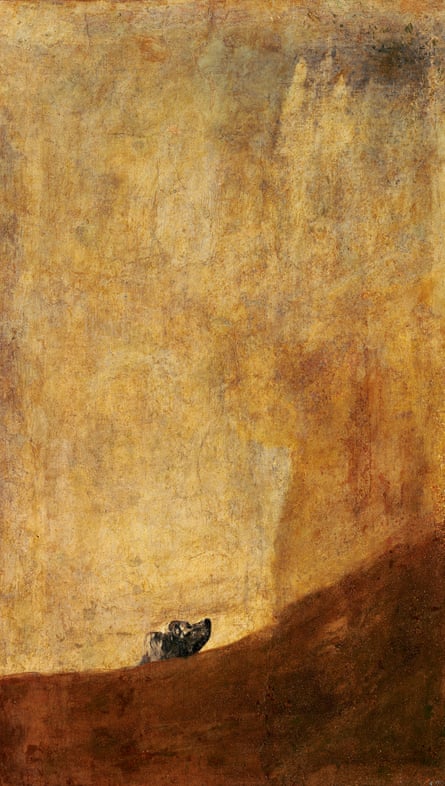
Throughout 2019, the museum is celebrating its bicentennial with high-profile events, including an exhibition of Goya’s drawings spanning his career, from early student sketches in Italy to the last lithographs he made in France. The Black Paintings also turn 200 this year, if only approximately. None of them was dated, signed or formally named by the artist, who never spoke or wrote about them as far as we know, and never intended them to be seen by the public.
Like some phantasmagorical form of interior design, they were painted directly on to the walls of the farmhouse just outside Madrid that Goya bought in 1819. He was 73, ancient by the standards of the day, and alienated from the Spanish royal court where he had painted for half of his life. By this time, he had also been profoundly deaf for decades. Over the next few years, Goya conjured face-melting visions in dark oils and projected them on the plaster – wrapping hallways, staircases and living spaces in hellacious murals for his own contemplation.
Almost half a century after his death in 1828, they were stripped out by Baron Frédéric Émile d’Erlanger, who bought the place and had the pictures transferred to canvas by restorer Salvador Martínez Cubells. Badly damaged, and partly repainted in the process, they were shown at the Paris Exposition Universelle of 1878, where the British critic PG Hamerton took against them with true Victorian opprobrium, casting Goya as a “hyena” and these scenes as emanations from “a hideous inferno ... a disgusting region ... shapeless as chaos”.
Today, Goya is held up as one of the three pillars of the Prado’s permanent collection, along with his idol Diego Velázquez and Peter Paul Rubens. His work is said to form a bridge between those old masters and the great moderns, prophesying expressionism and surrealism, which doesn’t make them any easier on the eye.
“Some people can hardly even look at them,” says Teresa Vega, an art historian who leads guided tours in the museum and leaves that room for last. “I’ve had plenty of clients who didn’t like them at all. But when they walk in, they are always surprised. I don’t think I’ve ever seen a visitor whose expression hasn’t changed. Even a yawning teenager will wake up when they see them.”
It is not Vega’s job to tell visitors what a painting means, though with other masterpieces she can point them in the right direction by way of context. Confronted with a Goya horror show, such as Saturn Devouring His Son, she can only cite the Greek myth it draws on and invite the group to look into the mad eyes of the main figure. To her, these suggest “not evil, but a kind of shock at his own monstrousness”.
These pictures have been so studied, says Vega, that they have been almost overanalysed. “And still, today, none of us can claim, ‘I have it, I understand them.’ Their mystery makes them very appealing, but also very disturbing.” The various schools of thought around the Black Paintings include no end of psychiatric and pathological readings, many focused on the unknown, life-threatening illness that Goya suffered shortly before creating them.
Might their feverish intensity be somehow symptomatic of the eastern plague, viral encephalitis, a series of mini-strokes, cumulative lead poisoning by his own paint-making materials, or possibly a bout of paranoid dementia? Alternative interpretations lean more heavily on biography, proposing that Goya’s world view was darkened by the famine, poverty and cruelty he witnessed (and sketched) during the Peninsular war between Napoleon and Bourbon Spain; by the restoration of King Ferdinand VII and the denial of the new, enlightened country that was promised by the Spanish constitution of 1812.
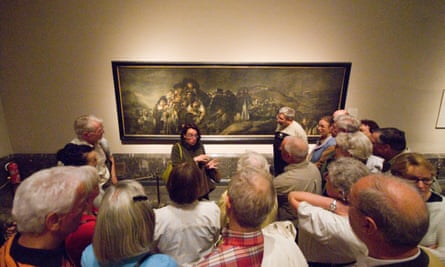
Manuela Mena sees none of this when she looks at the Black Paintings. The Prado’s former deputy director for conservation and research, she became the in-house Goya specialist some 30 years ago, believing a more scientific approach was needed. Part of her work involves parsing out the many pictures falsely attributed to him – including The Colossus, a once-major museum holding subsequently credited to a “follower of Goya”. More broadly, Mena is concerned with what can and cannot be said for certain about Goya’s life and work. She is “quite sure” that he painted the walls – when, for example, in 2003, Professor Juan José Junquera advanced a theory that he couldn’t have.
“Goya’s hand is there,” Mena says. “The strokes, the strength and the light, which is the main thing. His technique, his way of thinking.” Knowing him as well as anyone now living, she finds it “difficult to agree” with scholars who present the Black Paintings as a showcase for the artist’s political despondency, or his existential, edge-of-death despair. “All you hear about these pictures is how he was crazy, melancholic, pessimistic when he made them. But he was actually an optimist with a great sense of humour, very rational and very clear in his mind, right to the end of his life.”
The available documentary evidence makes for a nuanced character study. Goya was a country boy from Aragon who rose to the highest rank of any Spanish artist. A social climber who maintained a distaste for aristocrats. A man of the people with a loathing of the mob. A painter of luminous royal portraits and ethereal chapel frescoes who also made a worldly series of prints that he called Los Caprichos, satirising “the foibles and follies to be found in any civilised society”.
In those etchings and engravings, Goya used grotesques to illustrate his themes: witches, demons and goblins are metaphors for violence, ignorance, blind superstition. “The sleep of reason produces monsters,” he wrote beneath one of the most emblematic images. Mena believes the Black Paintings to be mockeries in the same spirit – cartoons he drew around himself as if the walls were “big sheets of paper”. Which is to say, she finds them funny.
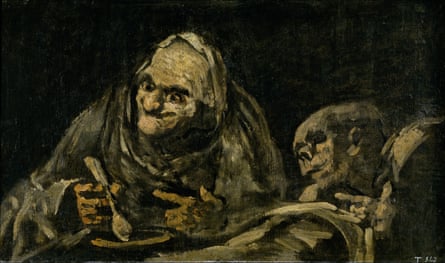
Two Old Men Eating Soup, for example, seems to her a kind of joke about greed. One of the men is practically a skeleton, already dead and decomposing, but still “eating like crazy, trying to get all he can”. She says: “Look at the expressions on the faces in these paintings, how each is a different personality. They’re not real, they’re caricatures, but they show Goya’s deep interest in human beings, in what we do and why. He was almost like a writer in a way, learning the worst about people and laughing about it in his work.”
The laughter I hear in the gallery this evening sounds nervous, incredulous. Nobody knows how to respond to these paintings. Even an expert like Mena can’t really tell them. Here was an artist operating in his own space and time, not communicating anything to anyone, expressing himself to himself alone. The results remain as personal, indelible and insoluble as dreams, which may be the very thing that makes them so strangely familiar.
I look at the howling mouths of the marching peasants in The Pilgrimage to San Isidro and wonder how they sounded to Goya, who hadn’t heard a thing for 25 years when he painted it. But I also think of refugees at a border, 200 years later.
And I keep coming back to The Drowning Dog, which is funny only in the sense that it makes me cry in public. What long-dead pet served as Goya’s model? The artist loved dogs and wrote about them often in his letters. It reminds me of my own dog, now old and grey around the snout. How long do we have left together? I look at this painting and I see in that poor animal our condition in general, and our historical moment in particular. I’m the dog and you’re the dog, our heads held just above a dark, rising tide.
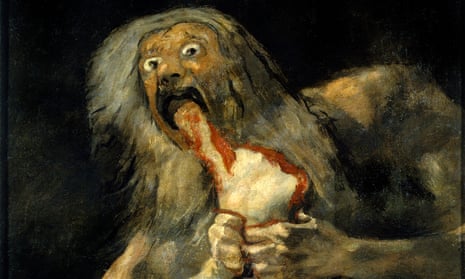
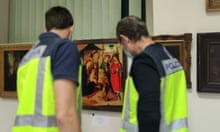
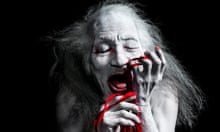


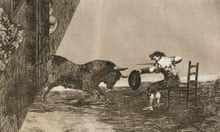


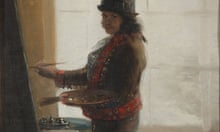
Comments (…)
Sign in or create your Guardian account to join the discussion